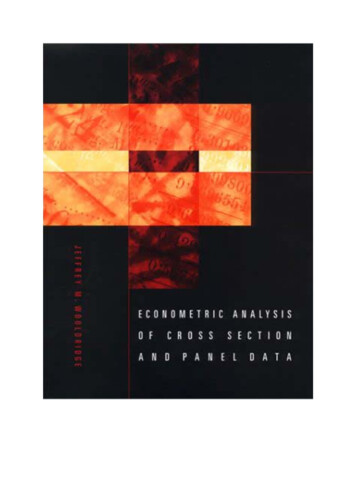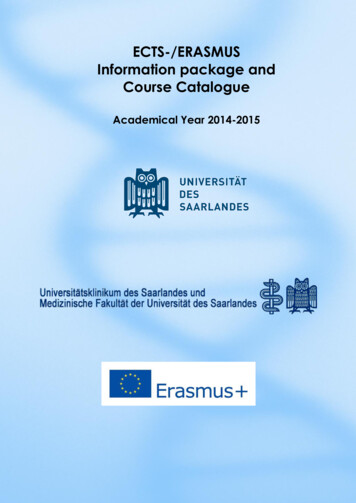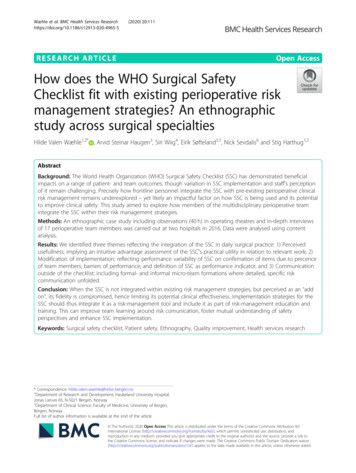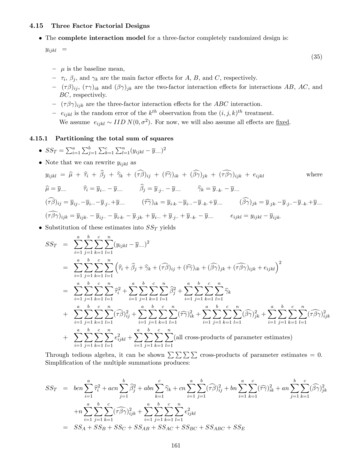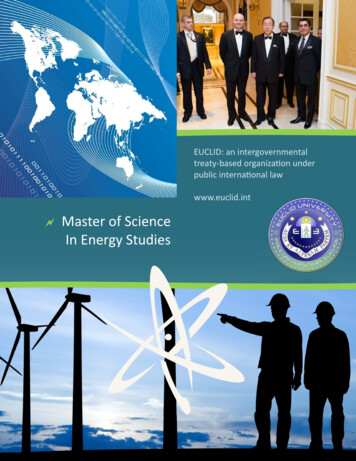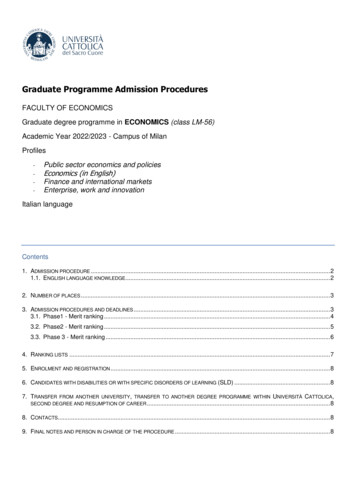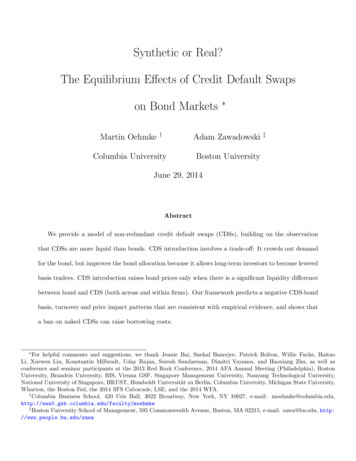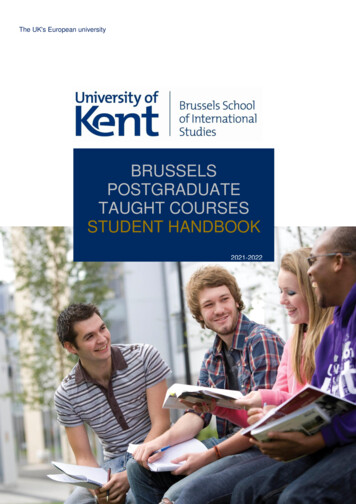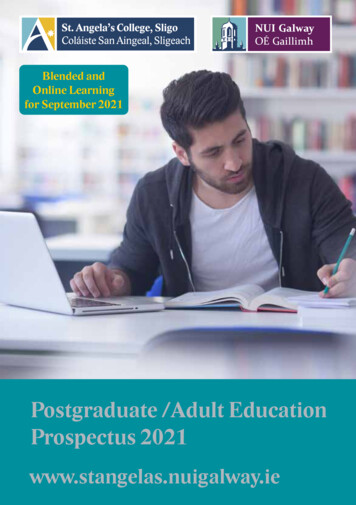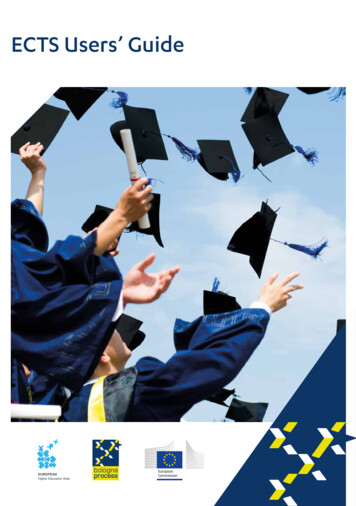
Transcription
ECTS Users’ Guide
ECTS Users’ Guide2015
ContentsIntroduction. 6Section 1ECTS key features. 10Section 2ECTS and the European Higher Education Area (EHEA).14Section 3ECTS for programme design, delivery and monitoring. 183.1 The programme context. 193.2 The programme profile. 213.3 The programme learning outcomes. 233.4 The programme structure and allocation of credits.243.5 Learning, teaching and assessment.263.6 Monitoring of credit allocation.28Section 4 ECTS for mobility and credit recognition. 304.1 Degree mobility. 304.2 Credit mobility.344.2.1 Before the credit mobility period. 354.2.2 After the credit mobility period. 364.2.3 Institutional rules and regulations. 374.3 Grade distribution. 394.4 Grade conversion. 41
Section 5 ECTS and lifelong learning. 445.1 Lifelong learning – open learning opportunities. 445.2 Recognition of prior learning and experience. 46Section 6 ECTS and quality assurance. 50Section 7ECTS and supporting documents. 547.1 Course Catalogue.547.2 ECTS and supporting documents for credit mobility. 577.2.1 Learning Agreement for credit mobility for studies.587.2.2 Learning Agreement for work placements.587.3 Transcript of Records. 607.4 Work Placement Certificate. 61Acknowledgements.64Annex 1 Glossary. 66Annex 2 Examples: grade conversion.80Annex 3 Recommended reading list. 84Annex 4 Examples: programme profiles. 92Annex 5 Examples: learning outcomes. 104
IntroductionThe European Credit Transfer and Accumulation System (ECTS) is a tool of theEuropean Higher Education Area (EHEA) for making studies and courses moretransparent and thus helping to enhance the quality of higher education.ECTS was instituted in 1989, within theErasmus programme, as a way of transferring credits that students earned duringtheir studies abroad into credits thatcounted towards their degree, on theirreturn to studying in their home institution. In the following years, it came to beused not only for transferring credits, onthe basis of workload and achieved learning outcomes, but also for accumulatingthem in institutions’ degree programmes.ECTS helps in the design, description and6delivery of programmes, makes it possibleto integrate different types of learning ina lifelong learning perspective, and facilitates the mobility of students by easingthe process of recognising qualificationsand periods of study. ECTS can be appliedto all programmes, whatever the mode ofdelivery (classroom-based, work-based,distance learning) or the status of students(full-time, part-time), and to all kinds oflearning contexts (formal, non-formal andinformal).
The ECTS Users’ Guide offers guidelinesfor implementing ECTS and links to usefulsupporting documents. Following the request from Bologna Ministers in Bucharest(Bucharest Communiqué, 2012), the ECTSUsers’ Guide of 2009 has been revised, inorder to strengthen the ‘meaningful implementation of learning outcomes’ in theEHEA. The Guide takes forward the objective of Ministers to ‘call on institutions tofurther link study credits with both learningoutcomes and student workload and to include the attainment of learning outcomesin assessment procedures’. This revisedversion is based on a solid foundation ofwork done in recent years, both within theBologna Process and in individual countries, to help the academic community andother stakeholders in higher education tomove in the direction of the changes advocated by the Bologna Process.The revised Guide takes into account recent developments in the Bologna Processsuch as the establishment of the EHEA,the consolidation of lifelong learning, theparadigm shift from teacher-centred tostudent-centred higher education, the increasing use of learning outcomes, and thedevelopment of new modes of learningand teaching. It includes a specific focus onprogramme design and delivery, and buildson the experience of higher educationinstitutions in using qualifications frameworks and in applying ECTS principles inacademic practice.The Guide is offered to students and otherlearners, academic and administrative staffin higher education institutions as well asto employers, education providers and allother interested stakeholders. For ease ofreading, the term ‘student’ is used to refer to all learners in higher education institutions (whether full-time or part-time,engaged in distance, on-campus or workbased learning, pursuing a qualification orfollowing stand-alone educational units orcourses).The revised Guide has been written by aworking group of practitioners appointedby Bologna countries and stakeholders’ associations. It has been submitted for consultation to stakeholders’ associations, experts from countries in the EHEA, and theBologna Follow-up Group. The EuropeanCommission has coordinated the draftingand consultation process. Finally, the Guidehas been adopted by Ministers for HigherEducation of the European Higher Education Area in 2015 at the Yerevan ministerialconference. It is therefore the official Guidefor the use of ECTS.7
1ECTS key features
ECTS key featuresECTS is a learner-centred system for credit accumulation and transfer, basedon the principle of transparency of the learning, teaching and assessment processes. Its objective is to facilitate the planning, delivery and evaluation of studyprogrammes and student mobility by recognising learning achievements andqualifications and periods of learning.ECTS credits express the volume of learning based on the defined learning outcomes and their associated workload.60 ECTS credits are allocated to the learning outcomes and associated workload ofa full-time academic year or its equivalent,which normally comprises a number ofeducational components to which credits(on the basis of the learning outcomes andworkload) are allocated. ECTS credits aregenerally expressed in whole numbers.Learning outcomes are statements of whatthe individual knows, understands andis able to do on completion of a learningprocess. The achievement of learning outcomes has to be assessed through procedures based on clear and transparent criteria. Learning outcomes are attributed toindividual educational components and toprogrammes at a whole. They are also usedin European and national qualificationsframeworks to describe the level of the individual qualification.110Workload is an estimation of the time theindividual typically needs to complete alllearning activities such as lectures, seminars, projects, practical work, work placements1 and individual study required toachieve the defined learning outcomes informal learning environments. The correspondence of the full-time workload of anacademic year to 60 credits is often formalised by national legal provisions. In mostcases, workload ranges from 1,500 to 1,800hours for an academic year, which meansthat one credit corresponds to 25 to 30hours of work. It should be recognised thatthis represents the typical workload andthat for individual students the actual timeto achieve the learning outcomes will vary.This Guide uses « work placement » or « placement », « training period », « internship » and « traineeship »as synonyms.
Allocation of credits in ECTS is the processof assigning a number of credits to qualifications, degree programmes or single educational components. Credits are allocatedto entire qualifications or programmes according to national legislation or practice,where appropriate, and with reference tonational and/or European qualificationsframeworks. They are allocated to educational components, such as course units,dissertations, work-based learning andwork placements, taking as a basis the allocation of 60 credits per full-time academicyear, according to the estimated workloadrequired to achieve the defined learningoutcomes for each component.Awarding credits in ECTS is the act of formally granting students and other learnersthe credits that are assigned to the qualification and/or its components if theyachieve the defined learning outcomes.National authorities should indicate whichinstitutions have the right to award ECTS2credits. Credits are awarded to individualstudents after they have completed the required learning activities and achieved thedefined learning outcomes, as evidencedby appropriate assessment. If studentsand other learners have achieved learningoutcomes in other formal, non-formal, orinformal learning contexts or timeframes,credits may be awarded through assessment and recognition of these learningoutcomes.Accumulation of credits in ECTS is theprocess of collecting credits awarded forachieving the learning outcomes of educational components in formal contexts andfor other learning activities carried out ininformal and non-formal contexts. A student2 can accumulate credits in order to:- obtain qualifications, as required bythe degree-awarding institution;- document personal achievements forlifelong learning purposes.The question of whether to refer to ‘students’ or ‘learners’ was discussed in depth in the working group andwith stakeholders. The position reached recognises and welcomes the fact that higher education is movingtowards more flexible provision; it also recognises the fact that most higher education systems are organisedaround provision of formal programmes to a clearly defined student body. While it was deemed prematureto use only the term ‘learner’ in the Guide, the term ‘student’ is used to encompass all learners in highereducation institutions (whether full-time or part-time, engaged in distance, on-campus or work-basedlearning, pursuing a qualification or following stand-alone educational units or courses).11
Transfer of credits is the process of having credits awarded in one context (programme, institution) recognised in anotherformal context for the purpose of obtaininga qualification. Credits awarded to studentsin one programme may be transferred froman institution to be accumulated in anotherprogramme offered by the same or another institution. Credit transfer is the key tosuccessful study mobility. Institutions, faculties, departments may make agreementswhich guarantee automatic recognitionand transfer of credits.12ECTS documentation: The use of ECTScredits is facilitated and quality enhancedby the supporting documents (Course Catalogue, Learning Agreement, Transcript ofRecords, and Work Placement Certificate).ECTS also contributes to transparency inother documents such as the DiplomaSupplement.
2ECTS and the EuropeanHigher Education Area(EHEA)
ECTS and the European Higher EducationArea (EHEA)In 1999 the Bologna Declaration included ECTS among the main objectives to beachieved by countries participating in the Bologna Process. Through the reformsimplemented in the course of the Process, ECTS has become a key tool of theEuropean Higher Education Area (EHEA).ECTS is adopted as the national credit system in most countries of the EHEA. In otherregions of the world, it is increasingly usedby institutions or interacts successfully withlocal credit systems3 based on comparablecriteria, thus playing a role in the growingglobal dimension of education.Within the EHEA, ECTS increases the transparency and readability of the educationalprocess and thus plays an effective role instimulating change and modernisation, because its implementation encourages theparadigm shift from a teacher-centred toa learner-centred approach, which is, under the term of Student-Centred Learning(SCL), recognised as an underlying principle of the EHEA.By using learning outcomes and workload in curriculum design and delivery,ECTS places the student at the centre ofthe educational process. Moreover, usingcredits makes it easier to create and document flexible learning pathways, thusallowing students greater autonomy andresponsibility.314Due to its outcome-based approach, theuse of ECTS serves other purposes of theEHEA:yy It facilitates the recognition ofprior learning and experienceand encourages a higher level ofcompletion and wider participation inlifelong learning;yy It establishes a closer link betweeneducational programmes andsocietal requirements and enhancesinteraction with all stakeholders,including the world of work and widersociety;yy It facilitates mobility within aninstitution or country, from institutionto institution, from country tocountry, and between differenteducational sectors and contextsof learning (i.e. formal, non-formal,informal and work-based learning),through recognition and credittransfer.In national legislation the use of ECTS canbe a requirement for accreditation of higher education programmes or qualifications.ECTS has inspired the development of credit systems in other regions, for example in Southeast-Asia,Latin America and most recently in Africa.
Nota BeneStudent-Centred Learning (SCL) is a process of qualitative transformation forstudents and other learners in a learning environment, aimed at enhancingtheir autonomy and critical ability through an outcome-based approach.The SCL concept can be summarised into the following elements:yy Reliance on active rather than passive learning;yy Emphasis on critical and analytical learning and understanding;yy Increased responsibility and accountability on the part of the student;yy Increased autonomy of the student;yy A reflective approach to the learning and teaching process on the part ofboth the student and the teacher.15
3ECTS for programmedesign, delivery andmonitoring
ECTS for programme design, delivery andmonitoringThis section deals with the design of educational programmes by highereducation institutions (HEIs) or by other providers. The use of ECTS credits aidsprogramme design by providing a tool which improves transparency and helpsto engender a more flexible approach to curriculum design and development.Nota BeneFrom an institutional perspective, designing a programme means planning a curriculum and its components in credits, indicating learning outcomes and associatedworkload, learning activities and teachingmethods and assessment procedures/criteria. The institutional credit frameworkshould cater for the needs of different programmes and support inter- and multi-disciplinary approaches.The use of ECTS in HEIs requires both an institutional credit framework based on institutional regulations and a profound understanding of the system by each member ofthe academic staff. Some institutions fosterthis understanding by regular training forstaff members. Team-based decisions onprogramme design enhance the coherence of the programme.An independent learner may accumulate the credits required for theachievement of a qualification through a variety of learning modes. She/hemay acquire the required knowledge, skills and competence in formal, nonformal and informal contexts: this can be the result of an intentional decisionor the outcome of different learning activities over time. The learner mayselect educational components without immediate orientation towards aformal qualification. ECTS supports this process, as described in Section 5 onLifelong Learning.The following steps have been identified as helpful in designing programmes.18
3.1 The programme contextWhen a new programme is developed, the first decision typically concerns the level of thequalification to be awarded, which is defined on the basis of the relevant national legislation and existing qualifications frameworks (European, national, sectoral, institutional).Nota BeneIt will be evident that not all learning outcomes are at the same level – hence the full implementation of a credit system requires level descriptors.There are two European Qualifications Frameworks: the Framework forQualifications of the European Higher Education Area (QF-EHEA) and theEuropean Qualifications Framework for Lifelong Learning of the EU (EQFLLL). Both frameworks use learning outcomes to describe qualifications (e.g.Bachelor, Master, Doctor) and are compatible with each other as far as HigherEducation is concerned (QF-EHEA cycles 1, 2 and 3 correspond to EQF-LLLlevels 6, 7 and 8) and cover qualifications at ISCED levels 6, 7, 8.In the QF-EHEA, three main cycles, as well as a short cycle, are identified anddescribed by the so-called Dublin Descriptors, in terms of: applying knowledgeand understanding, making judgments, communication skills, and learning tolearn. The short, first and second cycles are also characterised by credit ranges:yy Short cycle qualifications typically include approximately 120 ECTScredits.yy First cycle qualifications typically include 180 or 240 ECTS credits.yy Second cycle qualifications typically include 90 or 120 ECTS credits, witha minimum of 60 ECTS credits at the level of the second cycle.yy The use of ECTS in the third cycle varies.19
Nota BeneThe EQF-LLL describes ‘levels of qualification’ (without indicating anycredit ranges) – to provide a common reference framework which assists incomparing the national qualifications systems, frameworks and their levels. Itis based on eight levels.yy As an instrument for the promotion of lifelong learning, the EQFencompasses general and adult education, vocational education andtraining as well as higher education.yy The eight levels cover the entire span of qualifications from thoseachieved at the end of compulsory education to those awarded at thehighest level of academic and professional or vocational education andtraining.yy Each level should in principle be attainable by way of a variety ofeducation and career paths.yy Learning outcomes are specified in three categories – as knowledge,skills and competence. This signals that qualifications – in differentcombinations – capture a broad scope of learning outcomes, includingtheoretical knowledge, practical and technical skills, and socialcompetences where the ability to work with others will be crucial.The different cycles of QF-EHEA are referenced to the levels of EQF-LLL asfollows:yy Short-cycle qualifications at level 5yy First-cycle qualifications at level 6yy Second-cycle qualifications at level 7yy Third-cycle qualifications at level 8National education systems may include levels other than those included inthe overarching frameworks as long as national frameworks are self-certifiedand referenced against the QF-EHEA and the EQF. For example, while theEQF comprises 8 levels, the number of levels in national frameworks currentlyranges from 7 to 12. Therefore, the fact that short cycle qualifications are included in the QF-EHEA does not oblige countries to include such qualifications in their national frameworks but it gives explicit recognition to the factthat many national frameworks do include short cycle qualifications.20
The QF-EHEA and the EQF provide overarching frameworks against which nationaland institutional frameworks and descriptors should be calibrated.National frameworks are normally moredetailed than these overarching frameworks, reflecting the range of tertiary qualifications offered in the country.Higher Education Institutions which implement ECTS as a credit system will need aninstitutional framework which correlateswith the national and international frameworks. The institutional framework will indicate how ECTS credits are to be used, normally specifying a minimum credit value foran educational component to facilitate inter/multi-disciplinary programmes (whichwill be created by combining educationalcomponents from across a range of disciplines). European and national frameworksindicate the level of the final qualification.Thus, institutions, recognising that not allcredits acquired in progressing towards aqualification are at the same level (learningoutcomes achieved in the third year of aBachelor degree, for example, will tend tobe more complex than those achieved inthe first year) – may specify intermediatecredit levels with appropriate descriptorswhich (together with progression rules)will help students in progressing alongtheir learning pathways.Before designing the programme in detail,it should be set in the context of institutional and departmental mission statements, professional specifications (regulations, requirements), and the institutionalacademic framework for credit allocation.It is also recommended to carry out a needsanalysis and to consult with stakeholders(employers, graduates, society at large) toascertain the demand for the programme.3.2 The programme profileThe profile presents the distinctive features of the programme (Lockhoff et al., 2010). Itindicates the field(s) of study (which may be expressed in ISCED-F codes), the level of theprogramme, the main focus, the key learning outcomes expected on completion, thelearning environment and the main learning, teaching and assessment activities. An effective programme profile will make it clear to students and stakeholders what genericand subject specific competences will be developed and the employability potential of theprogramme. For this purpose, it is recommended that the profile is defined in consultationwith relevant stakeholders (such as academic peers, social partners, employers, graduates,and student representatives) and is presented in a clear and transparent way.The profile should be part of the programme description included in the Course Catalogue.21
Nota BeneAcross the EHEA, the terms ‘learning outcomes’ and ‘competence’ are usedwith different shades of meaning and in somewhat different frames of reference.For the purpose of this Guide:Competence means ‘the proven ability to use knowledge, skills and personal,social and/or methodological abilities, in work or study situations and inprofessional and personal development. In the context of the EuropeanQualifications Framework, competence is described in terms of responsibilityand autonomy’ (Recommendation 2008/C 111/01). Competences can begeneric or subject–specific. Fostering competences is the object of a processof learning and of an educational programme.Learning outcomes express the level of competence attained by the studentand verified by assessment. They are ‘statements of what a learner knows,understands and is able to do on completion of a learning process’ (Ibid.). Theyare formulated by academic staff, involving students and other stakeholders.In order to facilitate assessment, these statements need to be verifiable.22
3.3 The programme learning outcomesNota BeneThe programme learning outcomes are based on the programme profile and describe whata student knows, understands and is able to do on completion of the programme.Formulating programme learning outcomesConsiderable care needs to be taken in formulating learning outcomes. The following non-exhaustive list provides a set of guidelines which has proved to be helpful.yy The learning outcomes should adequately reflect the context, level, scopeand content of the programme.yy The statements of learning outcomes have to be succinct and not too detailed.yy The learning outcomes have to be mutually consistent.yy The learning outcomes should be easily understandable and verifiablein terms of what the student has actually achieved at the end of theprogramme.yy The learning outcomes have to be achievable within the specified workload.yy The learning outcomes have to be linked with appropriate learning activities,assessment methods and assessment criteria.yy There are no rules on the ideal number of learning outcomes at programmelevel. Experience suggests that between 10 and 12 is appropriate.yy A widely accepted way of formulating learning outcomes is based on threeessential elements.1. Use an active verb to express what students are expectedto know and be able to do (e.g. graduates can ‘describe’,‘implement’, ‘draw conclusions’, ‘assess’, ‘plan’).2. Specify what this outcome refers to (object or skill e.g. canexplain the ‘function of hardware-components’, or can presentthe ‘design of a living-room by hand’).3. Specify the way of demonstrating the achievement of learningoutcomes (e.g. ‘to give an overview of the materials most oftenused in electro-engineering’; ‘to develop a research design byapplying up-to-date scientific methods’, etc.).The programme learning outcomes should be included in the Course Catalogue and in theDiploma Supplement.23
3.4 The programme structure and allocation of creditsThe programme profile is broken down into educational components which may consist ofsingle or several modules, other types of course unit, work and clinical placements, researchprojects, laboratory work and other relevant learning activities. They may also include socialand community activities (for example, tutoring and mentoring) provided they fit the programme learning outcomes and carry credits.Learning outcomes, with related assessment strategies and assessment criteria, should bedefined for each educational component.Nota BeneThe learning outcomes of the programme and of its educational components are oftenmapped to demonstrate their mutual reinforcement. Many institutions use a matrix tocorrelate the learning outcomes of the degree programme with those of its educationalcomponents.Learning outcomes in educational componentsThe principles for formulating learning outcomes for educational componentsare the same as for programme learning outcomes.There are no absolute rules on the ideal number of learning outcomes for aneducational component. It will depend on the level and the nature of the unit,as well as the estimated workload. However, good practice suggests that thenumber should be limited and general experience indicates that 6 to 8 is anappropriate number.The annex contains a recommended literature list with guidelines on learningoutcomes.24
After the constituent parts of the programme have been identified, the overallstructure should be outlined and creditsallocated to each component, on the basis of its learning outcomes and associated workload, taking into account that 60credits correspond to a full-time-equivalent academic year.When educational components are of regular size (e.g. 5, 10, 15) they are often called‘modules’. In a programme made up ofmodules (a modularised structure), halfcredits may be used when justified (for example, in the case of 4 modules per semester), but other decimals should be avoided.It is helpful if the institution determines thebasic credit currency in terms of the minimum number of credits for a component asthis will facilitate collaboration on curriculaacross subjects and faculties.Establishing ‘mobility windows’ in the curriculum will facilitate learning mobility. Mobility windows may be prescribed both incontent and timing in the programme design or may allow flexibility in timing and incontent for the individual student. Mobilitywindows are preferably not used to replicate what would be studied at home, butto allow students to benefit from diverseeducational experiences in other settings.Progression requirements must be explicitif students are to navigate the programmesuccessfully and obtain the intended qualification. Progression requirements may include inter alia prerequisites, co-requisitesand recommendations. Progression rulesmay be expressed in terms of the numbers of credits or credit ranges requiredat different stages within a programme ofstudy (e.g. a minimum number of credits required to pass from one academicyear/semester to another). They may alsobe formulated in terms of detailed ruleson what components must and/or can betaken at what stage and of what level (e.g.compulsory courses, optional courses andprerequisites).Independent learners joining a formal programme should receive appropriate counselling/advice to support them in complying with progression requirements. Whererelevant, this counselling shoul
The ECTS Users' Guide offers guidelines for implementing ECTS and links to useful supporting documents. Following the re-quest from Bologna Ministers in Bucharest (Bucharest Communiqué, 2012), the ECTS Users' Guide of 2009 has been revised, in order to strengthen the 'meaningful im-plementation of learning outcomes' in the EHEA.
